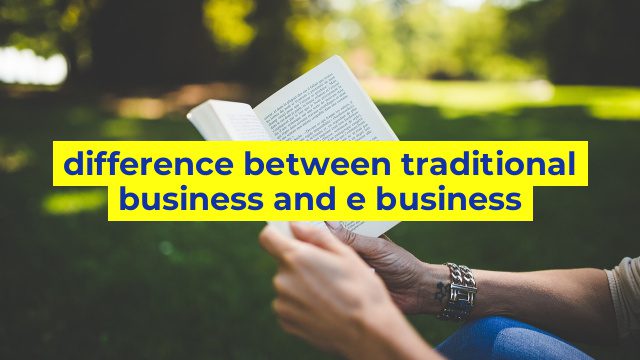The Differences Between Traditional Business and E-Business
Introduction
The traditional way of doing business has been around for centuries, but the rise of technology has brought a new form of business: e-business. One of the most significant differences between these two methods is the way they operate.
Location
The first difference lies in location. Traditional business usually requires a storefront in a physical location to reach clients. In contrast, e-business operates online and can reach customers worldwide, without the need for a physical storefront. This primarily benefits small businesses that do not have a lot of resources for renting or purchasing commercial space.
Worktime
Traditional businesses operate during specific hours, typically from 9 am to 5 pm. E-business, on the other hand, works 24/7 since it operates online, and customers can purchase or receive services at their convenience. This presents a significant advantage, as customers can access services at any time, and businesses can be operational round the clock.
Credibility
Another significant difference is credibility. Traditional businesses have high market credibility, that comes from having a physical store, established track record, and physical presence in the community. On the other hand, E-business is relatively new, and many customers may be wary of online transactions. They require strong customer reviews, certifications, and badges to establish credibility and earn customer trust.
Costs
One significant difference between these two business models is the cost of starting up. Traditional businesses require large amounts of capital for building, staffing, and financing advertisements. E-business, while it requires a significant initial investment in technological infrastructure, is significantly less costly in the long run, as running an online business requires fewer staff and overhead costs.
Marketing
Traditionally, businesses used word of mouth, traditional advertising, and networking to reach their clients. E-business, with its global reach, employs digital marketing techniques, including SEO, social media marketing, and pay-per-click advertising, to reach a vast audience.
In Conclusion
In conclusion, the differences between traditional business and e-business are significant, and entrepreneurs need to consider each model’s strengths and weaknesses before choosing a business model. While traditional businesses remain predominant in many industries, e-business offers significant advantages, not commonly found in the conventional model. Ultimately, the decision depends on the entrepreneur’s business goals, resources, and long-term strategy.
Table difference between traditional business and e business
Difference Between Traditional Business and E-business
| Aspect | Traditional Business | E-business |
|---|---|---|
| Location | Physical presence required | Can operate from anywhere with internet access |
| Operating Hours | Fixed operating hours | 24/7 availability |
| Customer Reach | Local or regional reach | Global reach |
| Customer Interaction | Face-to-face interaction | Online interaction |
| Costs | Higher operational costs due to physical location and overheads | Lower operational costs as there is no physical location or overheads |
| Inventory Management | Manual inventory management | Automated inventory management |
| Marketing | Traditional advertising and marketing methods | Online advertising and marketing methods |
| Payment Processing | Manual payment processing | Automated payment processing |
| Security | Relies on physical security measures | Relies on online security measures such as encryption and firewalls |


